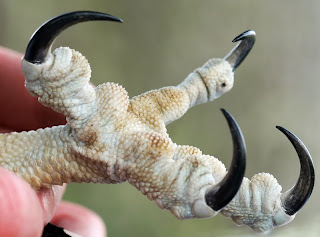A very unique bird of prey
that I would like to introduce to you is the Osprey (Pandion haliaetus).
Ospreys are so special
that they are in a class all their own.
There are eight different classes of birds of prey; Eagles, Hawks,
Falcons, Owls, Vultures, Condors, Kites, and Ospreys.
Bennett the Osprey
At World Bird Sanctuary we have a very
special bird named Bennett--our only Osprey. Bennett was found in a field in Wentzville, Missouri in the
cold of February 2013. It was a
very rainy day as well and he was soaked to the skin when he was rescued.
When Bennett was examined
at our hospital it was discovered that he did not have any physical
injuries. He appeared to have
arthritis in his joints. He was
very fortunate to have been found, as he most likely would have perished if not
rescued.
Bennett got his name from
Bennett Springs Park and Hatchery in Lebanon, Missouri. The conservationists there are lifetime
adoptive parents. Their fish
hatchery donates their excess fish to WBS to help feed the birds. And, since the Osprey’s main food is
fish Bennett receives some of that fish as his meal. Below is a picture of Bennett.
Ospreys are found on every
continent of the earth except Antarctica.
These birds eat about 99% fish in their diet, so they are found mainly
around waterways, such as rivers, lakes, and coasts. In North America, they are found on the Gulf Coast of
Florida, and the Gulf of California year round. During breeding season their range extends to Alaska, Canada,
and many parts of the continental U.S.
During the winter they migrate towards the California coast and Texas
coast. They will migrate as far
south as Mexico, and even into South America.
The name Osprey actually
means bird of prey (avis prede)
in Latin. Ospreys range from
3-4.5lbs (1400-2000g) in weight and stand at a height of 1.75-1.9 ft (21-23in)
tall. They have an astounding
wingspan ranging from 5-6 feet long as well.
Do you know what sets
ospreys apart from other birds of prey?
Believe it or not, it’s their feet! Ospreys have feet that are zygodactyl, which means that they
have two toes pointing forward and two toes pointing backward. However, one backwards toe can move
forward if needed. The only other
birds of prey that have zygodactyls feet are owls. Ospreys are the only diurnal (day active) birds to have
these special feet. All other
birds of prey have anisodactyl feet.
This means they have three toes pointing forward and one pointing
backward. Below you can see the
difference between an osprey’s foot and a peregrine falcon’s foot.
Photo of an Osprey foot
Photo of a Peregrine Falcon foot
Bennett is thought to be
around 15-20 years old because of his behavior. An Osprey’s
lifespan in the wild is usually around this same range. In captivity however their age can be
as much as 30-35 years old. The
oldest recorded wild osprey was 25 years and 2 months old. Some different
reasons why animals live longer in captivity include a steady diet, no
predators, medical attention available, and housing available as well. Since Bennett has arthritis, we
sprinkle Arthriease on his fish every day.
Bennett is available for
adoption in our Adopt a Bird program.
To find out more information, call 636-861-3225. All adoption donations are tax
deductible.
Bennett can be seen on the
exhibit line just past the World Bird Sanctuary Wildlife Hospital, mostly
during warm months.
The World Bird Sanctuary
is open daily from 8am-5pm 363 days of the year.
Bennett is a very
interesting bird. You should stop
on by and visit him!
Submitted by Lisbeth
Hodges, World Bird Sanctuary Naturalist







1 comment:
Osprey are not the only diurnal raptor with zagodactyl feet. Some members of the kite family, specifically of the genus "Elanus" have facultative zagodactyl feet. One example in North America is the white-tailed kite.
Post a Comment